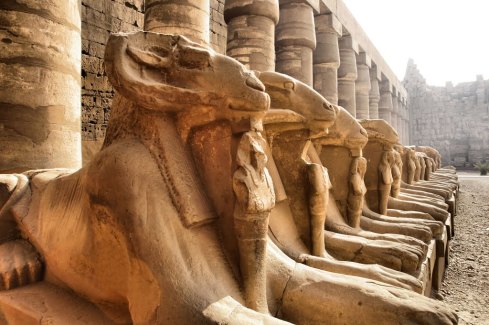You are currently browsing the tag archive for the ‘Mesektet’ tag.
Ancient Egyptian mythology can seem like a baffling tangle of multi-faceted gods who subsume each others’ identities, roles, and symbols. Perhaps the best way to understand the mutable nature of Egyptian deities is to recognize that the pantheon reflected the changing political realities of Ancient Egyptian culture. The drawback with this methodology is that the culture of Ancient Egypt lasted for approximately 3000 years (!), so it is still not easy to summarize Egyptian mythology.
Consider the deity Amun Ra. Amun Ra ended up as the king of the gods of Egypt—the emperor of heaven who created all things. There were times in the New Kingdom, when worship of Amun Ra bordered on monotheism and the other gods were regarded as flickering extensions of Amun Ra. However it did not start this way. Originally Amun and Ra were separate. In the Old Kingdom Amun was a mysterious god of hidden magical breath. The Old Kingdom ended in 2181 BC in a dark age of war and strife which lasted for a century (a time now known as “the First Intermediate Period”). At the end of this period, Amun had grown in importance and become the god of the winds and the patron god of Thebes. The Middle Kingdom was a glorious age for Egyptian civilization, but it too came to an end in stagnation, civil war, and invasion—”the Second Intermediate Period”–which lasted from 1786 BC to 1550 BC. During this Second Intermediate Period, a mysterious group of heterogeneous invaders—the Hyksos—took over Egypt and created their own dynasties. The Hyksos were finally driven from Egypt by nobles from Thebes who founded the 17th dynasty (the first of the New Kingdom). Since Thebes was politically ascendant, the Theban patron god Amun merged with Ra and became ruler of the gods. Before being combined with Amun, the deity Ra had long been worshiped as the sun god.
Ra traveled through the firmament on two solar boats. By day he traveled through the sky on the Mandjet (the Boat of Millions of Years). At night he took on his form as a great ram and traveled through the underworld on the Mesektet (the evening boat). Ferrebeekeeper has touched on the Mesektet before, but we were concentrating on giant evil snake deities back in those days, so ram-headed Ra didn’t really get his due in the earlier post.
Amun Ra had several forms which reflected his diverse origin, but he was most often portrayed as a mighty ram or as a pharaoh with a distinctive towering headdress…or sometimes as a falcon with the sun on his head. When I started writing this article I had hoped for some explanation of why Ra was called “Ram of the Underworld” or why the ram came to prominence over other animals to wind up as the favored animal head for the king of the gods, but if such explanations exist, they have eluded me. You’ll have to be content with the fact that the king of the gods of Egypt was most often a ram. I’m not even sure if I said that right: but I guess I don’t need to worry about literalistic ancient Egyptian priests and worshipers showing up in the comments to berate me (a consideration which crossed my mind when I decided to write about Amun Ra as opposed to other supreme sheep gods whom I could name).





